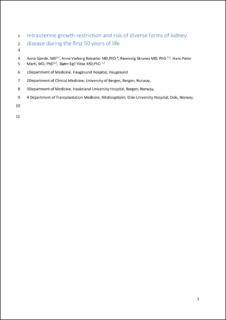| dc.description.abstract | Background and objectives: Previous studies have shown that individuals with low birth weight (LBW) or small for gestational age (SGA) have higher risk of kidney failure. This study investigates birth-related exposures and risk of CKD and other kidney diagnoses.
Design, setting, participant, & measurements: The Medical Birth Registry of Norway has registered extensive medical data on all births in Norway since 1967. The Norwegian Patient Registry has registered diagnostic codes for all admissions and outpatient visits to Norwegian hospitals since 2008. Data from these registries were linked, and risk of CKD and other groups of kidney disease were analyzed using logistic regression statistics. LBW (below the tenth percentile), SGA (birth weight below the tenth percentile for gestational age), and preterm birth (<37 weeks) were analyzed as exposures.
Results: A total of 2,663,010 individuals were included. After a mean follow-up of 26 years (maximum 50 years), 4495 had been diagnosed with CKD and 12,818 had been diagnosed with other groups of kidney disease. LBW was associated with an odds ratio (OR) for CKD of 1.72 (95% confidence interval [95% CI], 1.60 to 1.90), SGA with an OR of 1.79 (95% CI, 1.65 to 1.94), and preterm birth with an OR of 1.48 (95% CI, 1.33 to 1.66). Analyses using diagnosis of CKD at stages 3–5 as end point showed similar results. Results were similar for men and women. We analyzed adjusted ORs for other groups of kidney disease and found that LBW was associated with an adjusted OR of 1.44 (95% CI, 1.33 to 1.56) for acute kidney disease, 1.24 (95% CI, 1.14 to 1.36) for GN, 1.35 (95% CI, 1.17 to 1.56) for cystic kidney disease, and 1.15 (95% CI, 1.06 to 1.25) for kidney disease resulting from kidney or urinary tract malformations.
Conclusions: LBW, SGA, and preterm birth are associated with higher risk of CKD in the first 50 years of life. Risk of other groups of kidney disease was less pronounced. | en_US |
